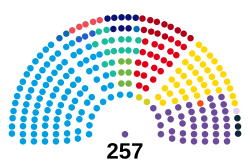|
Argentine Chamber of Deputies
The Chamber of Deputies (Spanish: Cámara de Diputados de la Nación), officially the Honorable Chamber of Deputies of the Argentine Nation, is the lower house of the Argentine National Congress (Spanish: Congreso de la Nación). It is made up of 257 national deputies who are elected in multi-member constituencies corresponding with the territories of the 23 provinces of Argentina (plus the Federal Capital) by party list proportional representation. Elections to the Chamber are held every two years, so that half of its members are up in each election, making it a rare example of staggered elections used in a lower house. The Constitution of Argentina lays out certain attributions that are unique to the Chamber of Deputies. The Chamber holds exclusive rights to levy taxes; to draft troops; and to accuse the president, cabinet ministers, and members of the Supreme Court before the Senate. Additionally, the Chamber of Deputies receives for consideration bills presented by popular initiative. The Chamber of Deputies is presided over by the president of the Chamber (Spanish: Presidente de la Cámara), who is deputized by three vice presidents. All of them are elected by the chamber itself. Current compositionIt has 257 seats and one-half of the members are elected every two years to serve four-year terms by the people of each district (23 provinces and the Autonomous City of Buenos Aires) using proportional representation (list PR), D'Hondt formula with a 3% of the district registered voters threshold, and the following distribution: By province
By political groups127 of the current members of the Chamber of Deputies for the 2023–2025 period were elected in the 2021, while the remaining 130 were elected in 2023 legislative election. The governing La Libertad Avanza alliance, to which President Javier Milei belongs, is the second largest parliamentary bloc with 38 deputies, while the main opposition, Union for the Homeland, holds the first minority with 99 deputies.
RequirementsIndividuals elected to congress must be at least twenty five years old with at least four years of active citizenship and it has to be naturalized in the province that is being elected to or at least have two years of immediate residency in said province. (Art. 48 of the Argentine Constitution). HistoryThe Chamber of Deputies was provided for in the Constitution of Argentina, ratified on May 1, 1853. Eligibility requisites are that members be at least twenty-five years old, and have been a resident of the province they represent for at least two years; as congressional seats are elected at-large, members nominally represent their province, rather than a district.[3] Otherwise patterned after Article One of the United States Constitution per legal scholar Juan Bautista Alberdi's treatise, Bases de la Constitución Argentina, the chamber was originally apportioned in one seat per 33,000 inhabitants. The constitution made no provision for a national census, however, and because the Argentine population doubled every twenty years from 1870 to 1930 as a result of immigration (disproportionately benefiting Buenos Aires and the Pampas area provinces), censuses were conducted generationally, rather than every decade, until 1947.[4] Apportionment controversyThe distribution of the Chamber of Deputies is regulated since 1982 by Law 22.847, also called Ley Bignone, enacted by the last Argentine dictator, General Reynaldo Bignone, ahead of the 1983 general elections. This law established that, initially, each province shall have one deputy per 161,000 inhabitants, with standard rounding; after this is calculated, each province is granted three more deputies. If a province has fewer than five deputies, the number of deputies for that province is increased to reach that minimum. Controversially, apportionment remains based on the 1980 population census, and has not been modified since 1983; national censuses since then have been conducted in 1991, 2001, 2010, and 2022. The minimum of five seat per province allots the smaller ones a disproportionately large representation, as well. Accordingly, this distribution does not reflect Argentina's current population balance.[5] Presidents of the ChamberThe president of the Chamber is elected by a majority of the Chamber's members. Traditionally, the presidency is held by a member of the party or alliance of the national executive, though exceptions have occurred, such as in 2001, when the Peronist Eduardo Camaño was elected president of the Chamber during the presidency of the radical Fernando de la Rúa.[6] The officeholders for this post since 1983 have been:
Current authoritiesLeadership positions include:
See alsoReferences
External linksWikimedia Commons has media related to Parliaments of Argentina. |
|||||||||||||||||||||||||||||||||||||||||||||||||||||||||||||||||||||||||||||||||||||||||||||||||||||||||||||||||||||||||||||||||||||||||||||||||||||||||||||||||||||||||||||||||||||||||||||||||||||||||||||||||||||||||||||||||||||||||||||||||||||||||||||||||||||||||||||||||||||||||||||



